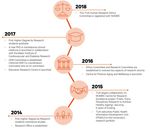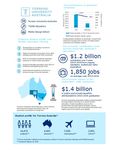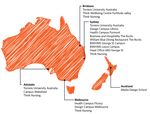South Australian Productivity Commission Inquiry into Health and Medical Research Submission May 2020 - SA Productivity Commission
←
→
Page content transcription
If your browser does not render page correctly, please read the page content below
SA HMR Inquiry 2020 Submission: Torrens University
South Australian Productivity Commission Inquiry into Health and Medical
Research
Submission
May 2020
Torrens University
Professor Justin Beilby
Deputy Vice Chancellor Research
Torrens University Australia
Torrens University Australia (Torrens) is Australia’s newest university. Since its inception, it has
aimed for excellence in both teaching and research. Late 2015 saw the passing of Australian
Government legislation establishing Torrens University Australia (Torrens) as a Table B
university.
Torrens is a private sector university owned by Laureate International Universities, the
world’s largest educational network. The university is a for-profit enterprise with B Corp
certification. Headquartered in Adelaide, Torrens also has a national campus footprint, with
teaching and research locations in Brisbane, Sydney and Melbourne.
Consistent with its focus on innovation, Torrens University is committed to the strategic focus of
developing curriculum and research programs in Health, Organisational Agility, Education,
Creative Technologies and Artificial Intelligence. Torrens research is founded on a strategy of
partnerships with external organisations to deliver research outcomes with industry, business
and community impact. The university h a s actively engaged in value-adding research
partnerships with the three South Australian Universities, South Australian Health and Medical
Research Institute (SAHMRI), Health Translation SA and Industry Partners. Torrens has also
established national partnerships with OPAL Aged Care, Austin Health and Baker Health and
Diabetes Institute in Victoria. Across the Laureate Global University network, Torrens has
fostered research affiliations with Universities in USA, South America, India and South East
Asia. It also has active research affiliations with Universities in Africa.
Torrens University Research Evolution
From inception in 2014, Torrens has grown rapidly to include multiple areas of world-class
excellence in research, launch five dedicated research centres and foster a growing cohort of
higher degree by research students. There have been many key development milestones
including:
2014 Research Office was established. First PhD and MPhil students commenced.
2015 First collaboration with National Health and Medical Research Council
(NHMRC) funded Centre of Research Excellence. Public Health Information
Development Unit (PHIDU) joined Torrens research portfolio.
Page 1 of 5SA HMR Inquiry 2020 Submission: Torrens University
2016 Research & Research Ethics Committees launched. Torrens Health Research
Centre launched.
2017 First PhD and MPhil students graduated. Torrens Education Research Centre
launched.
2018 Torrens Business Research Centre established. Research Ethics Committee
achieved NHMRC registration.
2019 Torrens Design Research Centre and AI Research Centre established.
NHMRC awarded Torrens status as a grant administering institution.
2020 Multiple applications made to ARC and NHMRC competitive grant rounds.
In Health and Medical Research, Torrens has established several key focus areas. In establishing
these areas, the research leadership of the university has focused on building on our strengths
efficiently and strategically by actively creating mutually beneficial working partnerships across
the South Australian and Australian research community.
By its very nature, Torrens has proven in the education space its capacity to grow, innovate and
respond efficiently to the prevailing needs and circumstances of its students and industry partners.
The same strategy has been applied in the research space without needing to build substantial
and costly footprints that require significant resources to maintain. As a smaller, more agile
research entity, therefore, Torrens has been able to thrive in spaces (particularly around truly
collaborative health services and industry-led research) where the larger entities in SA are simply
too cumbersome/non-competitive. This advantage is likely to be enhanced in the Medical
Research Future Fund (MRFF) applications.
Torrens University Health and Medical Research priorities
(1) Cardiopulmonary Health
Professor Simon Stewart (an NHMRC Senior Principal Research Fellow) is a world-renowned
health services researcher leading a national and international health services collaborative
research program focussing on cardiopulmonary health.
Communicable and non-communicable diseases affecting the cardiovascular system and/or
lungs (cardiopulmonary disease - CPD) are the leading cause of death and disability in Australia
and on a global basis. Accordingly, its greater contributor (cardiovascular disease) remains a
National Health Priority Area currently affecting 1 in 20 Australians adults overall and 1 in 5 of
those aged >75 years. Professor Stewart’s overall aim is to better characterise the burden
imposed by an evolving epidemic of CPD and develop highly innovative/cost-effective health
services that reduce high levels of morbidity and premature mortality. In collaboration with
national/international collaborators and industry partners and with support from the NHMRC of
Australia and other prestigious peer-review funding schemes, Professor Stewart is addressing
three unique facets of the burden of disease imposed by CPD. When this program of research is
complete, it will deliver considerable cost-savings and economic benefits to Australia and
Page 2 of 5SA HMR Inquiry 2020 Submission: Torrens University
participating countries. The three main facets of his research are – a) reducing seasonal patterns
of cardiopulmonary disease; b) improving the efficient use of echocardiography and c) improving
the CPD detection and management in Africa.
(2) Frailty and Ageing
This program of research is led by Professor Justin Beilby in partnership with Drs Rachel
Ambagtsheer and Elsa Dent.
Professor Justin Beilby is an academic GP with long standing expertise in primary care and aged
care research, health service evaluation, general practice intervention studies, and the translation
of research findings into policy and clinical practice. Dr Rachel Ambagtsheer is a Research Fellow
with more than 20 years’ experience working in the health field, as a researcher, planner and
consultant to all levels of government and the private and not-for-profit sectors. Her current
research focuses on the implementation of frailty screening within Australian general practice, the
relationship between frailty and mental health and exploring how older people interact with the
health system. As members of the NHMRC CRE for Frailty and Healthy Ageing, Professor Beilby
and Dr. Ambagtsheer have co-authored several publications on frailty, including one of the largest
diagnostic test accuracy studies conducted within general practice to date.
Torrens, in partnership with the Baker Heart and Diabetes Institute, also hosts Dr. Elsa Dent, an
NHMRC Early Career Fellow who is an internationally recognised expert on frailty and a member
of the WHO Clinical Consortium for Healthy Ageing. Dr. Dent recently led two collaborative
international projects developing clinical guidelines for frailty and has recently completed a
commissioned review on frailty for The Lancet.
(3) Artificial Intelligence and Data Science
Torrens hosts researchers who are world-leaders in Artificial Intelligence and Robust
Optimisation. Robust Optimisation is the concept of achieving an optimal balance between
operational efficiency and resistance to disruptions from unpredictable events. This research
area provides transformational subject matter expertise (SME) to any type of health research,
development or innovation project which involves the use of computer modelling or electronic
systems – prototyping and manufacture, autonomous systems, cyber and surveillance systems,
computational analysis of research and more.
Assoc. Prof. Mirjalili is a specialist in Optimisation, Nature-inspired Algorithms, Machine
Learning, and Data Science. He has authored or co-authored over 150 publications, including
110 journal articles, 30 book chapters, 15 conference papers, two research monographs, and
three edited books. With over 16,000 citations and a Google Scholar H-index of 44, he was
named as an influential researcher in Computer Science by Web of Science in the list of 1%
highly-cited researchers. In the 2019 list, he is one out of 271 highly-cited researchers from
Australia (6,216 worldwide) of which only nine of them are in the category of Computer Science
(107 computer scientists worldwide). He was also featured as a rising star in the Science and
Engineering category of The Australian’s research supplement in 2019. He is a senior member
of The Institute of Electrical and Electronics Engineers (IEEE) and an Associate Editor of four
Page 3 of 5SA HMR Inquiry 2020 Submission: Torrens University
leading, Q1 journals in Artificial Intelligence.
(4) Public Health Information Development Unit (PHIDU).
The PHIDU commenced at Torrens in November 2015. This Unit is led by Professor John Glover.
Funded by the Australian Government Department of Health since 1999, PHIDU, as per the
funding agreement, collects, compiles and publishes data ‘to facilitate improved national policies
and programs in population health including social determinants of health and health inequalities.
This is achieved largely through the widely recognised and utilised Social Health Atlas of
Australia; a substantial and important small area database that is a unique resource not matched
in Australia. With data in some instances dating back to the 1980s, it has been possible to produce
time-series analyses and the identification of trends over considerable periods. Examples of use
of the data within government agencies include:
• Advice from the past Director of Public Health, Victorian Department of Health and Human
Services that it was noticeable how many times data from PHIDU was quoted to support
submissions over a wide range of topics.
• Communication from the Indigenous Health Division of the Australian Government
Department of Health that maps and data from PHIDU’s Aboriginal and Torres Strait Islander
Social Health Atlas were used in presentations to the minister to support new resource
allocation based on the need for primary health care.
• Supporting local councils to meet the requirements under the new Public Health Act in South
Australia – relevant data were extracted from the general Social Health Atlas for incorporated
local government areas and from the Aboriginal and Torres Strait Islander Social Health Atlas
for Aboriginal Lands and ‘out-of-council’ areas.
The main outputs are an interactive Atlas (mapping data describing health status, health
outcomes and the socioeconomic and demographic contexts of the neighbourhoods and localities
in which Australians live), interactive graphics (highlighting variations in these same elements by
remoteness and socioeconomic status), data sheets and metadata. These products are available
free of charge on the Torrens University website with 34,909 users over calendar 2019, 23,140
of whom were new users. Most users were from Australia (49.9%) and the United States (43.4%).
RESPONSE TO SPECIFIC TERMS OF REFERENCE
In establishing a thriving program of health and medical research as a new University, it has been
crucial for us to build upon existing research networks. Over the last six years, Torrens academic
staff members have worked in partnership with the three public Universities, SAHMRI, Interstate
research networks (Austin Health and Baker Heart and Diabetes (Vic)), Laureate International
Universities, and more recently with the South Australian Local Networks. There have been a
number of key lessons we have learned that may be useful to SAPC in finalising their
recommendations.
1) Whole of Government HMR Strategy and Minister and CEO leadership vital
In positioning Torrens to be an active partner in HMR research in South Australia, the absence of
a whole of Government and health system agreed and supported HMR strategy made our task
more difficult. While the major HMR contributors (three public Universities and SAHMRI) have
relatively well-defined roles, other smaller research organisations are unclear how they would
neatly and strategically fit into an overall HMR Strategy.
Page 4 of 5SA HMR Inquiry 2020 Submission: Torrens University
2) Bespoke and agile HMR organisations have a role but in collaborative frameworks
Torrens looked widely in South Australia to engage with collaborative partners and networks.
Whilst our options were abundant, they required significant effort. Our flexible and agile single
point of contact with a very clear and laser focus on where our research priorities lie was crucial
to facilitating successful partnerships. What is abundantly clear is that there are many
opportunities for building creative partnerships within the South Australian HMR community.
However, what is needed is an efficient State-wide facilitator who can establish and create
conversations with like-minded research groups. I am not convinced that the major Universities
are best at this task as they are by nature focused on their own priorities. SAMHRI may have a
facilitating role here but this would require a shift in their current strategy.
3) “SA MRFF” Future Fund linked to Local Health Networks (New Boards/Chairs)
Torrens has led or been a partner to a range of new MRFF grant proposals in 2020, with a focus
on ageing and cardiopulmonary disease. We have focussed on building successful research
relationships with the newly established Local Health Networks. As the State moves forward with
an increased HMR grant success focus (particularly via MRFF funding) we will need to develop
these applications in partnership with the Networks. Seed funding in the form of a “SA MRFF”
fund could be used to drive these partnerships, underpinned by established research MOUs and
with a shared vision between all participating organisations. This must be part of an agreed
broader SA HMR Strategy (see 1 above).
4) Fostering partnerships across MRFF, BioMed Precincts, Innovation Precincts – role
for Health Translation SA
In a broader sense, South Australia has an abundance of research and innovation precincts. Our
view is that we now need a partnership facilitator that draws together Universities, SAHMRI,
bespoke private research providers and appropriate Industry to build longer-term vision for
research development. It is possible that Health Translation SA could be tasked with this role
working closely with the Chief Entrepreneur and other precinct leaders.
5) International Researcher and student workforce models – Quality of Life-Adelaide
In just over 5 years, Torrens has established an international student base and in 2020 will
educate more than 2,000 students via our Adelaide campus and online. Many of these committed
and talented students would like to settle in Adelaide, due in part to our local quality of life and
safety. As the State builds a new HMR strategy there is an opportunity to work closely with Study
Adelaide and the Department of Tourism, Trade and Investment to create packages to attract
new emerging and outstanding research leaders from within this large and talented cohort.
Page 5 of 5May 2020 Torrens University Australia Health and medical research capability UNIVERSITY RESEARCH “START UP” CASE STUDY
Torrens University Australia
• Australia’s youngest and most dynamic
university
• South Australia based, with a national
campus footprint.
• An agile private sector organization.
• Rapidly growing research capability
including world-class publications and talent in
Medical & Health Sciences
2
• A research identity founded on industry and
government collaborations and
partnerships.
• Part of the Laureate International
Universities, the largest educational network
in the world.Torrens Research Publications
6
Torrens Research Investment (ABS Higher Education Research & Experimental)
Development Survey
2016 2018 % Increase
Total Research Expenditure $ 1,958,000.00 $ 3,790,000.00 93.56%
University Research Funding $ 1,092,564.00 $ 2,660,580.00 143.5%
External Research Funding $ 865,436.00 $ 1,129,420.00 30.5%
Total Person Years of Effort (PYE) 18.00 38.25 112.5%7
Public Health Information Development Unit
based at Torrens University
8
Federally funded research data unit focusing on monitoring inequality in health and wellbeing, and for
supporting opportunities to improve population health outcomes.Torrens Research International Collaborations 2015-2020
9Torrens Future Research Talent
• PhD students first began in 2014
• Cohort of HDR students with rapid growth year-on-year
• The future researcher capability of the university
• 4 Students have graduated as at April 2020
Current Higher Projected 2020 Projected 2021 Projected 2022 Projected 2023
Degree Research graduations graduations graduations graduations
Students
Staff Students 22 1 1 5 7
10
Non-Staff Students 39 10 4 7 7
Total (Intl) 61(24) 11(8) 5(3) 12(0) 14(2)
Total in Medical & 23 4 2 2 4
Health research
fieldsInquiry into Health and Medical Research in South Australia
Lessons learnt
Private Sector contribution Agile and nimble infrastructure
Torrens Uni by its very nature has proven in the
Recognition/support of smaller, more agile research
education space, its capacity to grow, innovate
entities to enable them to thrive in spaces (particularly
and respond to the prevailing needs and
around truly collaborative health services and industry-
circumstances of its students and industry
led research) where the larger entities are simply too
cumbersome/non-competitive. This advantage is likely
partners. We are doing the very same thing in 11
the research space without needing to build
to be enhanced via the MRFF funding streams.
substantial footprints that require significant
resources to maintain.Inquiry into Health and Medical Research in South Australia
Lessons learnt
Collaboration - key strategy PHIDU experience
The health system is well supported by clinical,
Public Unis – all three
administrative and population health data.
SAHMRI /Health Translation
However, there is limited evidence that the
Tonsley/Lot 14/BioMed City system is linking and analysing this data or
Laureate International Universities disseminating results to inform decision making 12
Interstate Health and Research Networks e.g. across the health system for continuous
Austin Health and Baker Heart and Diabetes (Vic) improvement purposes.
SA Local Health Networks – new focus nowInquiry into Health and Medical Research in South Australia
Lessons learnt
Final Comments
Bespoke and agile HMR organisations have a role but in collaborative frameworks
“SA MRFF” Future Fund linked to Local Health Networks (New Boards/Chairs)
Fostering partnerships across MRFF, BioMed Precincts, Innovation Precincts – role for
Health Translation SA 13
Whole of Government HMR Strategy and Minister and CEO leadership vital
International Researcher and student workforce models – Quality of Life-Adelaide
Unified State based Ethics CommitteesYou can also read



























































